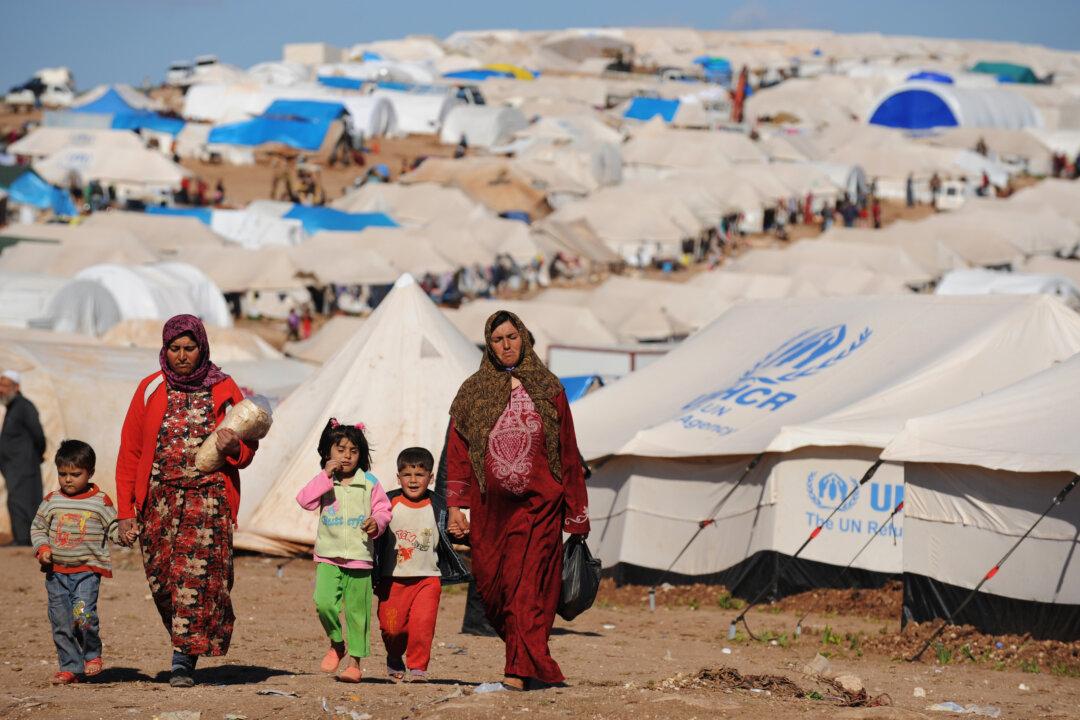WASHINGTON—The number of people who have been forced to flee their homes due to armed conflict, human rights violations, or natural disasters, to seek shelter elsewhere in their own country was estimated worldwide to be 28.8 million at the end of 2012—an increase of 2.4 million from 2011 and an all-time high.
The internally displaced persons (IDPs) outnumber by nearly two to one all the refugees in the world who have fled their countries.
The Norwegian Refugee Council and its Internal Displacement Monitoring Centre (IDMC), published these findings in its report, “Global Overview 2012,” last month. The Brookings Institution held a panel discussion on the report and what needs to be done to improve aid and protection for IDPs in Washington, D.C., on May 24, which included representatives of the U.S. Department of State and U.S. Agency for International Development (USAID).
Generally speaking, refugees benefit from a long-established system of international law and assistance, while IDPs are less visible and frequently viewed as a lower priority. However, IDPs may have as much, or more, need for humanitarian aid and protection from violence than refugees.
The United Nations has one agency that oversees assistance and protection for refugees, but when IDPs need assistance or protection it “depends much on persuasion and time to get international agencies to take responsibility for the plight of the displaced,” said Elizabeth Ferris, Co-Director of Brookings’s Project on Internal Displacement, who served as moderator for the discussion.
This year around 6.5 million IDPs were newly displaced, which is nearly double the number of 3.5 million in 2011. The increase of newly displaced was attributed to armed conflicts in Syria and the Democratic Republic of Congo (DRC), which account for approximately half: 2.4 million in Syria and one million in the DRC. Next were Sudan and India, which each had an estimated 500,000 newly displaced in 2012.
Large Scale Displacements
In Syria, the number of IDPs grew to at least three million by the end on 2012. “Most have received very little or no assistance,” because aid is a divisive political issue in the country, says the report. Over 80 percent were newly displaced in 2012.
“The [Syrian] government is not only failing to help internally displaced persons, it is slaughtering them,” said Anne C. Richard, assistant secretary of the U.S. Bureau of Population, Refugees, and Migration (PRM), in a statement read at the discussion in her absence. She continued, “Troops attack civilians, people are bombed indiscriminately from the sky, hospitals and bakeries are targeted.”
Richard said that access to the Syrian people in need is difficult or impossible. “When John Ging of the U.N. Office for Coordination of Humanitarian Affairs (OCHA) tried to lead a convoy from Damascus to Aleppo, it had to pass 54 checkpoints manned by the regime and different opposition factions along the route.”
With the upsurge of violence last year, the number of IDPs in the DRC reached 2.7 million. In Somalia, the famine has caused between 1.1 and 1.36 million IDPs, but thankfully, famine conditions have come to an end.
The report estimates that in Mali, 227,000 people were driven from their homes as a result of the conflict in 2012.
Internal armed conflict and human rights abuses are the main causes for Colombia to remain the country with the highest number of IDPs in the world, with around 5 million. Richards gave an example of a newly displaced couple in Columbia: “A couple who farmed fled when they were given a choice: either agree to cook for combatants of illegal armed groups or they had one half-hour to leave.”
The report states that 2.1 million returned in 2012, a decrease of about 250,000 from 2011. However, it’s harder to count the returnees compared to the displaced. Typically, people leave en mass but the numbers “trickle” as they return, said Frank Smith, representing IDMC.
Addressing IDP Policy
There was consensus among the panelists of the direction that the U.S. government and international aid agencies, particularly the U.N. Refugee Agency (UNHCR), need to go.
Nancy Lindborg, USAID, said that the 2004 USAID policy for IDPs is “very outdated” and the agency is in the process of revising it.
Lindborg said she wants to see greater connectivity between the developmental and humanitarian teams to work jointly on their planning so as to address the needs of the internally displaced populations.
“The momentum to address the problem of the internally displaced has slowed,” said Joel Charney, who is vice president for humanitarian policy and practice at InterAction, the largest alliance of U.S.-based nongovernmental organizations focused on disaster relief and sustainable development programs.
Something has happened since the early 1990s when there was a strong global impetus in the United Nations to address IDP needs, he said, noting that momentum has all but disappeared.
Part of the reason for the slowdown is the notion that the problem has been successfully dealt with, he said.
Another reason is “mainstreaming” the internally displaced so that their problems are viewed as less serious than other problems in conflict areas. “There is still some reluctance to accept the idea that the internally displaced require special protection effort,” said Charney, who worked for Oxfam America for 16 years. He said priority should be given to the most vulnerable.
Richard had a similar view on the setting of priorities among aid recipients. She said that UNHCR, which PRM depends on greatly, should allocate its resources based firstly on humanitarian need, not how the persons are classified.
“In our view, IDPs are not a secondary priority,” Richard said. “UNHCR possesses a set of commitments to IDPs, and these commitments should not be a lower priority for the agency relative to its other populations of concern—refugees, returnees, and stateless persons.”
Countries With the Largest Number of Internally Displaced Persons (IDPs)
Colombia 4.9-5.5 million
Syria 3 million
Democratic
Republic of Congo 2.7 million
Sudan 2.2 million
Iraq 2.1 million
Somalia 1.1-1,36 million




